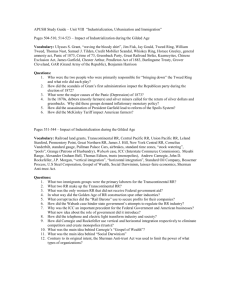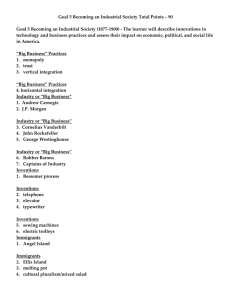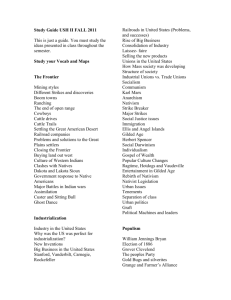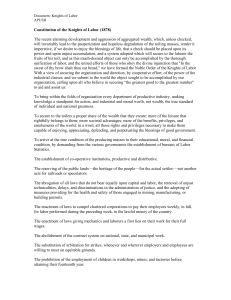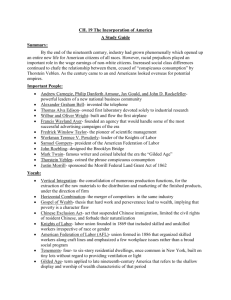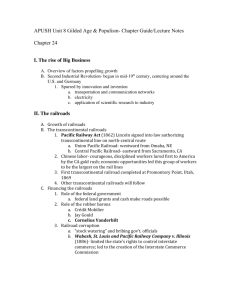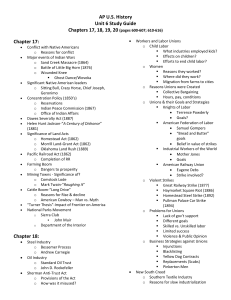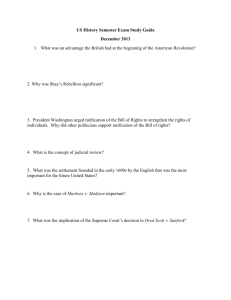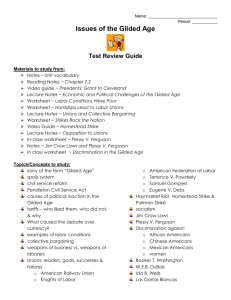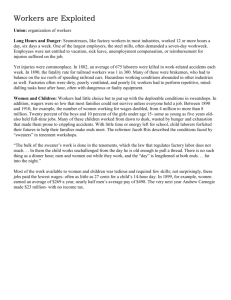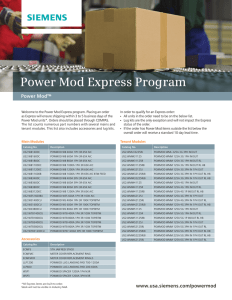Document
advertisement
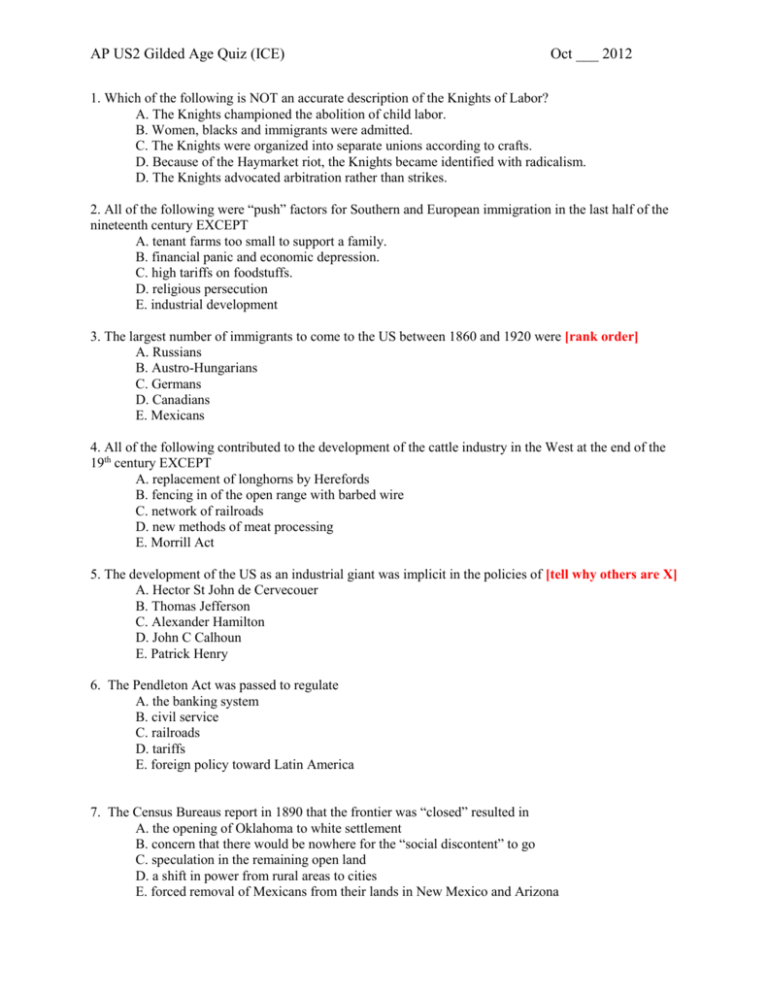
AP US2 Gilded Age Quiz (ICE) Oct ___ 2012 1. Which of the following is NOT an accurate description of the Knights of Labor? A. The Knights championed the abolition of child labor. B. Women, blacks and immigrants were admitted. C. The Knights were organized into separate unions according to crafts. D. Because of the Haymarket riot, the Knights became identified with radicalism. D. The Knights advocated arbitration rather than strikes. 2. All of the following were “push” factors for Southern and European immigration in the last half of the nineteenth century EXCEPT A. tenant farms too small to support a family. B. financial panic and economic depression. C. high tariffs on foodstuffs. D. religious persecution E. industrial development 3. The largest number of immigrants to come to the US between 1860 and 1920 were [rank order] A. Russians B. Austro-Hungarians C. Germans D. Canadians E. Mexicans 4. All of the following contributed to the development of the cattle industry in the West at the end of the 19th century EXCEPT A. replacement of longhorns by Herefords B. fencing in of the open range with barbed wire C. network of railroads D. new methods of meat processing E. Morrill Act 5. The development of the US as an industrial giant was implicit in the policies of [tell why others are X] A. Hector St John de Cervecouer B. Thomas Jefferson C. Alexander Hamilton D. John C Calhoun E. Patrick Henry 6. The Pendleton Act was passed to regulate A. the banking system B. civil service C. railroads D. tariffs E. foreign policy toward Latin America 7. The Census Bureaus report in 1890 that the frontier was “closed” resulted in A. the opening of Oklahoma to white settlement B. concern that there would be nowhere for the “social discontent” to go C. speculation in the remaining open land D. a shift in power from rural areas to cities E. forced removal of Mexicans from their lands in New Mexico and Arizona AP US2 Gilded Age Quiz (ICE) Oct ___ 2012 8. Which of the following statements about the labor market in the second half of the 19th century is NOT true? A. Union strikes and boycotts were considered “conspiracies in restraint of trade”. B. The national labor market was highly competitive because of the movement of farmers to cities and the influx of immigrants. C. The AFL effectively recruited and organized immigrants. D. A series of economic depressions drove wages down E. Installment of new machines sometimes resulted in technological unemployment 9. “The working class and the employing class have nothing in common. There can be no peace as long as hunger and want are found among millions of working people and the few, who make up the employing class, have all good things in life”. The statement above is most likely from the constitution of the A. Greenback Party B. Knights of Labor C. The Grange D. Industrial Workers of the World E. Congress of Industrial Organization 10. The Grange movement did all of the following EXCEPT [explain answer] A. successfully lobby for passage of laws in several states that set maximum railroad passenger and freight rates B. win Munn V Illinois C. support laissez-faire capitalism D. organize businesses such as mills, banks and grain elevators E. admit women on an equal basis with men 11. The Gilded Age can best be described as a period of A. intense political activity by the Presidents B. political agitation by western farmers C. labor unrest and combination of businesses D. unbridled use of the spoils systems and unregulated business competition E. laissez-faire attitude by government toward business 12. Organized labor would have supported which of the following demands in the “Omaha Platform” of the Populist Party in the 1892 election? A. an increase in currency resulting from the free and unlimited coinage of silver B. government ownership of railroads C. eight hour workday D. graduated income tax E. direct election of Senators 13. The Credit Mobilier scandal involved A. an attempt by Congress to raise its own pay and to collect two year’s of back pay B. a bribe by an Indian Trader to William Belknap, the Secretary of State C. “Boss Tweed” and the building of a courthouse in New York City D. the awarding of construction contracts on the Union Pacific railroad by a group of stockholders to their own company at inflated prices E. a ring of whiskey distillers and blackmailers who defrauded the US Government AP US2 Gilded Age Quiz (ICE) Oct ___ 2012 14. Division of labor in factories resulted in A. the manufacture of interchangeable parts B. the factory system C. mass production of goods D. the Bessemer steel process E. development of the electric dynamo 15. King Monopoly would most likely favor all of the following EXCEPT [explain each] A. labor unions B. high protective tariff C. cheap money D. US Expansionism E. unregulated immigration 16. The cartoonist who drew the picture would most likely favor the [explain all five] A. Bland-Allison Act B. Interstate Commerce Act C. Pendleton Act D. Sherman Antitrust Act E. Sherman Silver Purchase Act 17. The author of the “Gospel of Wealth” was A. Samuel Gompers B. John D Rockefeller C. Andrew Carnegie D. Frederick Taylor E. Eugene V Debs AP US2 Gilded Age Quiz (ICE) Oct ___ 2012 18. The first National Labor Union was the A. Knights of Labor B. National Labor Union C. American Federation of Labor D. Amalgamated Steel Workers E. International Workers of the World 19. Some big businessmen, such as A. Carnegie, vertically integrated their corporations by A. eliminating middlemen to control every aspect of production B. forbidding labor unions C. Buying competitor to form monopolies D. Inflating the price of their own stock E. Issuing uncompetitive rebates 20. Why did membership in the National Labor Union fade in the mid-1870s? A. Most members joined the American Federation of Labor instead B. The Depression of 1873 made jobs scarce. C. The economy boomed and workers didn’t need to bargain for wages, hours, and better working conditions. D. Americans didn’t like labor unions in the 1870s. E. Working conditions improved so the unions were unnecessary. 21. Which of the following was not a goal of labor unions in the 19th century? A. Eight hour work day B. Equal pay for all workers C. Job security D. Job perquisites (perks) such as vacation, sick days, etc E. Job safety 22. The first all-women’s national labor union was the [identify each] A. Daughters of Liberty B. Women’s Trade Union League C. Daughters of St Crispin D. National Consumer League E. Cigar Makers International Union 23. Which Supreme Court action made trade unions legal in the US? [identify each with year/issue] A. Munn v Illinois B. Wabash Case C. Commonwealth V Hunt D. Lochner V New York E. In re Debs
